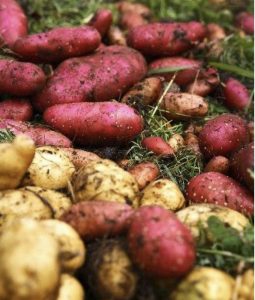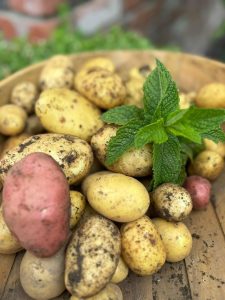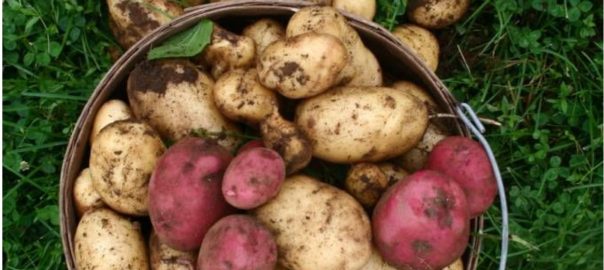Buckets of Potatoes!
Who doesn’t love a new potato, hot from the pot and smothered in butter and ground black pepper! But new potatoes are few and far between in February, and we need to be inventive if we want more. That’s where growing potatoes in buckets that can then be moved into the greenhouse once temperatures cool down, is the answer.
Right now, tomatoes and other summer vegetables are dominating the greenhouse, and it feels as though there’s no more space. But it won’t be long until those summer plants are spent and you’ll be ousting them to the compost. Even if they will stay in place for a few more months, tomato vines will have spaces between them as you trim off their lower leaves. And light will pour in as you pinch out leaves around trusses to let in the light to ripen the fruit. Which all means there will be space for your bucket potatoes once it’s time to move them under cover.

Source
Seed potatoes from nurseries can be hard to come by in February, so the best plan is to purchase them in January and keep them in a covered box to restrict growth until you are ready to plant them. However, if you have grown potatoes over summer, and have yet to harvest them, check for potatoes which that have been exposed to the light. You will find that some have begun to sprout short, hardy leaves. Or you may find a wild potato in the compost pile which is beginning to sprout. Remove your seed potato from the ground when you have your bucket prepared, and plant it as your seed.
Preparation
Choose a 9-10 litre household bucket or any similar plastic container or grow bag of this size and depth. Make several holes in the base of the container if it doesn’t already have these. Prepare your growing mix in a large tub or wheelbarrow. Commercial or home compost should form 80% of the mix. The remaining 20% can be made up of coconut coir, perlite or vermiculite, and sheep pellets. If not using sheep pellets, and you don’t mind using inorganic materials, add a couple of tablespoons of super phosphate to the mix, along with fertiliser pellets according to the instructions on the container. For an even better mix, add mycorrhizal fungi. This dry product is available from a number of outlets including Seacliff Organics, and it really gives plants a boost. Mix all your ingredients together thoroughly.
Planting
Fill your bucket to the half way mark with your growing mix. Place the potato in the centre of the mix, growing shoot upwards. If the seed potato doesn’t have leaves, cover it with 3cm of mix. If the seed potato already has some leaves, add just enough mix to cover the tuber, and leave no more than 5cm of the foliage exposed. Water the mix well enough to dampen, but not soak, it, and raise the bucket so that excess moisture drains away quickly. Place the bucket where it will receive plenty of sunlight (if you live in a very warm part of the country or temperatures are unseasonably high, place the bucket in dappled light – for instance, among shrubs).

Maintenance
Each time the foliage of your seed potato reaches a height of 15cm, add growing mix to the bucket so that only 5cm of leaf is protruding. Keep the growing mix damp but not wet, and water it with a liquid feed every week. The liquid feed can be made by soaking in water 2 cups of sheep pellets and some chopped seaweed and comfrey leaves. If the weather is very warm, you may like to add a mulch of straw or pine needles over the growing mix (but not the potato foliage) to help keep the soil damp. In strong winds, give the potato plant shelter.
The big move
Once cooler autumn temperatures arrive, carefully move the potato in the bucket into the greenhouse. Place it in a position where it will receive plenty of light. Remember that your greenhouse is providing optimal growing conditions, not just for your potato, but also for sap sucking insects such as aphids. If you spot these pest, gently rub the potato foliage between your fingers to squash them, or spray with a soap and water mix made from 1/4 teaspoon of hard bathroom soap dissolved in 500mls of boiling water (cool thoroughly before placing in a spray bottle). In the heat of the greenhouse, your potato may need watering more frequently.
Harvest
Bucket-grown potatoes take around 60 to 70 days to produce a crop. However, as you are growing your potatoes into autumn, you made need to allow a little longer. Check to see if the potatoes are read by gently removing a little growing mix from the bucket or by feeling down in the mix with your fingers.
Tips
The ideal temperature for potatoes to grow in is around 10-15°C. Use a thermometer to check the temperature in your greenhouse, and delay placing your potato plant under cover until the temperature suits it.
It is not necessary for the potato foliage to die off before harvesting your new potatoes.
If you live in a mountainous part of the country, frosts can arrive early, and a hard frost can damage potato foliage, even when the plant is in the greenhouse. In very cold regions, cover you potato with frost cloth if you are expecting temperatures to drop below zero.
If potato psyllid is a problem in your region, protect your potato from this pest by covering the foliage with a 0.3mm mesh.
In very warm weather, keep the roots of your potato cool, and its leaves in the sun, by placing other containers around it.
If it is possible to choose a variety of seed potato to plant, go for an ‘early.’
